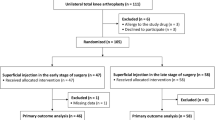Abstract
Purpose
To determine the accuracy and short-term efficacy of fluoroscopy-guided steroid/anesthetic injections for symptomatic pars interarticularis (pars) defects.
Materials and methods
Following IRB approval, all fluoroscopically guided pars injections from a single institution (6/2010 to 3/2016) were retrospectively and independently reviewed by two MSK radiologists. The radiologists evaluated the fluoroscopic images to determine if all of the pars injections associated with each procedure were intra-pars (n = 57 procedures; 106 pars injections), peri-pars (n = 3 procedures; three pars injected), or a combination of intra-pars and peri-pars (n = 6 procedures; 12 pars injected). The patients were asked their pain score (graded on a scale of 0–10) pre-injection, 5–10 min and 1-week post-injection. Age, gender, and fluoroscopic times were recorded. Statistical analysis was performed on the all intra-pars injections only.
Results
Exact inter-reader agreement was present in 92 % (112/121) of the injections, with 57 of the procedures (106 pars injections) performed on 41 patients (mean age 36; 18 M, 23 F) all intra-pars. The mean pre-injection and 5–10 min post-injection reduction in pain for the all intra-pars injections was −3.0 units (95 % CI: [−3.9, −2.1] units; p < 0.001) with a mean 1-week post-injection (n = 21 procedures; 38 pars) reduction in pain of −0.7 units (95 % CI [−1.5, 0.0]; p = 0.06). The geometric mean fluoroscopic time per pars injected was 42 s.
Conclusions
Over 92 % of fluoroscopically guided injections for symptomatic spondylolysis are technically successful with minimum fluoroscopic time, resulting in statistically significant pain reduction immediately post-injection and a trend in pain reduction 1-week post-injection.



Similar content being viewed by others
References
Wiltse LL, Widell Jr EH, Jackson DW. Fatigue fracture: the basic lesion is isthmic spondylolisthesis. J Bone Joint Surg. 1975;57A:17–22 [Am].
Fredrickson BE. The natural history of spondylosis and spondylolisthesis. J Bone Joint Surg. 1984;66A:669–707.
Kalichman L, Kim DH, Li L, Guermazi A, Berkin V, Hunter DJ. Spondylolysis and spondylolisthesis: prevalence and association with low back pain in the adult community-based population. Spine. 2009;34(2):199–205 (Phila Pa 1976).
Fujii K. Union of defects in the pars interarticularis of the lumbar spine in children and adolescents. J Bone Joint Surg. 2004;86-B:225–31. Br.
Lusins JO, Elting JJ, Cicoria AD, Goldsmith SJ. SPECT evaluation of lumbar spondylolysis and spondylolisthesis. Spine. 1994;5:608–12.
Blanda J, Bethem D, Moats W, Lew M. Defects of pars interarticularis in athletes: a protocol for nonoperative treatment. J Spinal Disord. 1993;6:406–11.
Ward CV, Latimer BP, Alander DH, et al. Radiographic assessment of lumbar facet distance spacing and spondylolysis. Spine. 2007;32:E85–88.
Petron DJ, Prideaux CC, Likness L. Interventional spine procedures in athletes. Curr Sports Med Rep. 2012;11(6):335–40.
Rossi F, Dragoni S. The prevalence of spondylosis and spondylolisthesis in symptomatic elite athletes: radiographic findings. Radiology. 2001;7:37–42.
Soler T, Calderon C. The prevalence of spondylolysis in the Spanish elite athlete. Am J Sports Med. 2000;1:57–62.
Mooney V, Robertson J. The facet syndrome. Clin Orthop. 1976;115:149–56.
Micheli LJ, Wood R. Back pain in young athletes. Arch Pediatr Adolesc Med. 1995;149:15–8.
Maldague B, Mathurin P, Malghem J. Facet joint arthrography in lumbar spondylolysis. Radiology. 1981;140:29–36.
Wald JT et al. A practice audit of CT-guided injections of pars interarticularis defects in patients with axial low back pain: a primer for further investigation. Pain Med. 2014;15:745–50.
Sarazin L et al. Lumbar facet joint arthrography with the posterior approach. Radiographics. 1999;19(1):93–104.
Huber PJ. The behavior of maximum likelihood estimates under nonstandard conditions. Proceedings of the Fifth Berkeley Symposium on Mathematical Statistics and Probability. 1967; vol. I, pp. 221–33.
White H. A heteroskedasticity-consistent covariance matrix estimator and a direct test for heteroskedasticity. Econometrica. 1980;48:817–38.
Schneiderman GA, McLain RF, Hambly MF, Nielsen SL. The pars defect as a pain source. A histologic study. Spine. 1995;20:1761–4.
Omidi-Kashani F, Ebrahimzadeh MH, Salari S. Lumbar spondylolysis and spondylolytic spondylolisthesis: who should behave surgery? An algorithmic approach. Asian Spine J. 2014;8(6):856–63.
Wu SS, Lee CH, Chen PQ. Operative repair of symptomatic spondylolysis following a positive response to diagnostic pars injection. J Spinal Disord. 1999;12:10–6.
Sys J, Michielsen J, Bracke P, et al. Nonoperative treatment of active spondylolysis in elite athletes with normal x-ray findings: literature review and results of conservative treatment. Eur Spine J. 2001;10:498–504.
Suh PB, Esses SI, Kostuik JP. The prognostic value of pars infiltration. Spine. 1991;16:S445–448.
McCormick CC, Taylor JR, Twomey LT. Facet joint arthrography in lumbar spondylolysis: anatomic basis for spread of contrast medium. Radiology. 1989;17:193–6.
Ghelman B, Doherty JH. Demonstration of spondylolysis by arthrography of the apophyseal joint. Am J Roentgenol. 1978;130(5):986–7.
El-Khoury GY, Renfrew DL. Percutaneous procedures for the diagnosis and treatment of lower back pain: discography, facet-joint injection, and epidural injection. Am J Roentgenol. 1991;157:685–91.
Author information
Authors and Affiliations
Corresponding author
Ethics declarations
Conflict of interest
There are no grants or conflicts of interest to disclose.
Rights and permissions
About this article
Cite this article
Kershen, L.M., Nacey, N.C., Patrie, J.T. et al. Accuracy and efficacy of fluoroscopy-guided pars interarticularis injections on immediate and short-term pain relief. Skeletal Radiol 45, 1329–1335 (2016). https://doi.org/10.1007/s00256-016-2427-2
Received:
Revised:
Accepted:
Published:
Issue Date:
DOI: https://doi.org/10.1007/s00256-016-2427-2




